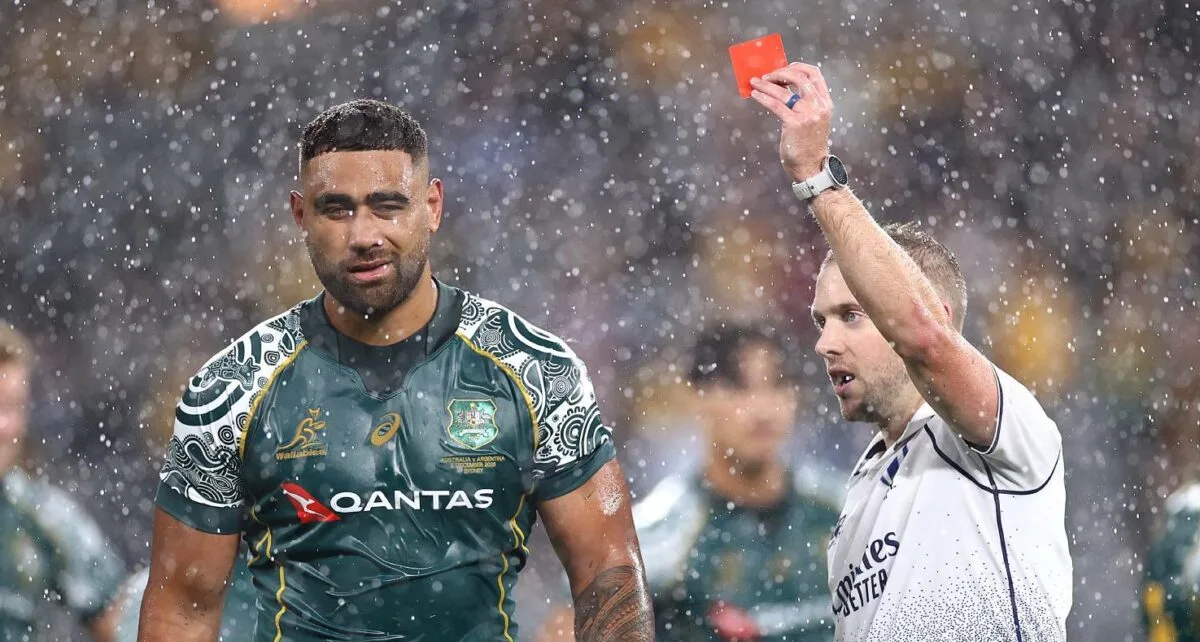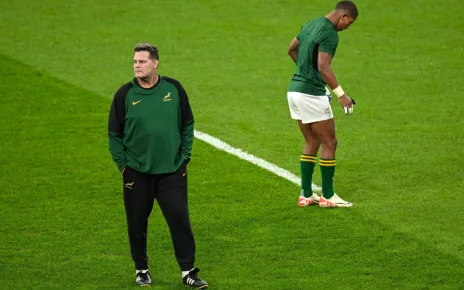As an idiot once said, rugby is a very simple game. Of course it’s not. It’s a fiendishly complicated game, labyrinthine in its rules, intricate in its execution and baffling in its spectacle. And that is what we love about it.
Simplicity is not our way. Leave that to lesser codes, with less refined supporters. Not for us rugby league’s “five tackles and a kick”, Australian Rules football’s “kick and catch” or soccer’s “leave the cash in a paper bag behind the fifth toilet along, fourth floor of FIFA headquarters”. Rugby has evolved beyond that.
Modern-day rugby has attained a state of intensely satisfying complexity. Currently there are over 1600 rules regarding the scrum alone, and quantum physicists have theorised that the breakdown disproves Einstein’s General Theory of Relativity. Yet the technicians of SANZAAR never rest on their laurels, always searching for the next big leap forward in abstruse technicality to prevent the game going stale.

Lukhan Salakaia-Loto of the Wallabies is given a red card during the 2020 Tri-Nations match between the Australian Wallabies and the Argentina Pumas at Bankwest Stadium on December 05, 2020 in Sydney, Australia. (Photo by Cameron Spencer/Getty Images)
This commitment to innovation is best demonstrated by the change announced for this year’s Rugby Championship concerning cards. Now, in addition to yellows and 20 minute reds, “full reds” will also be an option. So for a little naughtiness you get a yellow, for a moderate bit of mischief you get a 20 minute red, and for real evil you’re off for good.
This is all good, confusing stuff, a lovely reflection of rugby union’s traditional bewildering essence. The use of a single colour to represent two different punishments is especially pleasing. But does it go far enough?
In a game in which events can run down infinite rivulets of possibility, surely only having three ways of punishing violations is insufficient. As the poets have sung, man contains multitudes, and his motivations are legion. Any sport which aspires to depict the nature of humanity in all its savage beauty must surely make a greater effort to recognise this. I propose a new system, thus, in addition to the existing reds, yellows and blues (a blue card, I’m told, is for possible concussions, which is apt given that being concussed can really get you down).
WHITE CARD: This card sits at the bottom of the punishment pyramid. A referee will show a player a white card if he is guilty of demonstrating a bad attitude through, for example, eye-rolling, heavy sighing or grunting instead of giving a proper answer to the referee’s questions. If a player is shown a white card he does not have to leave the field, but he should know the referee is disappointed in him.
BEIGE CARD: This card is just above white, and will be shown to any player who the referee considers to be unnecessarily sarcastic. The player must leave the field for two minutes.
PALE YELLOW CARD: A pale yellow card is similar to a regular yellow, but only carries a five-minute penalty rather than ten. A pale yellow shall be shown for minor infringements or professional fouls if the referee considers that the offence was out of character and it’s not really like him at all. For example, if a player deliberately knocks down an opposition pass, but the referee knows him from church.
ORANGE CARD: This sits between yellow and red. A player will be shown an orange card, and be sent from the field for 15 minutes, if the referee hears a rumour of something the player has done which is really not on, and the referee at first didn’t want to believe it, but another person confirmed it and anything’s possible but really it’s hard to deny it any more isn’t it.
REDDISH CARD: This is almost the same as a 20 minute red, but for slightly worse offences: the player may be replaced after 20 minutes, but only by a randomly-selected member of the crowd.
DARK RED CARD: This is a full red, but will be shown if the referee wishes to indicate that he is really, really angry this time. For example, if a player makes a high tackle and a hurtful remark at the same time.
GREEN CARD: This card will be shown for any act of foul play that the referee considers to be so dangerous and deliberate that the player must be forced to emigrate. For example, money laundering.
BLACK CARD: This card carries the same punishment as a full red, but is specifically for players found by the TMO to have been performing acts of dark magic.
BROWN CARD: A brown card will be shown to the player if, in the referee’s judgment, he needs a bath.
GREY CARD: This card is for any player who should retire.
DOUBLE RED: A full red sends a player off for the whole game. A twenty-minute red sends him off for twenty minutes, after which he may be replaced. A double red does both of these at the same time. The player must try to figure out what this means for himself. If he cannot he will be shown a triple red, and must be replaced by three players at once.
PURPLE CARD: A purple card will be shown to any player who the referee finds especially attractive.
I’m open to suggestions for other cards, but you must admit, these would make the game a hell of a lot more fun.




